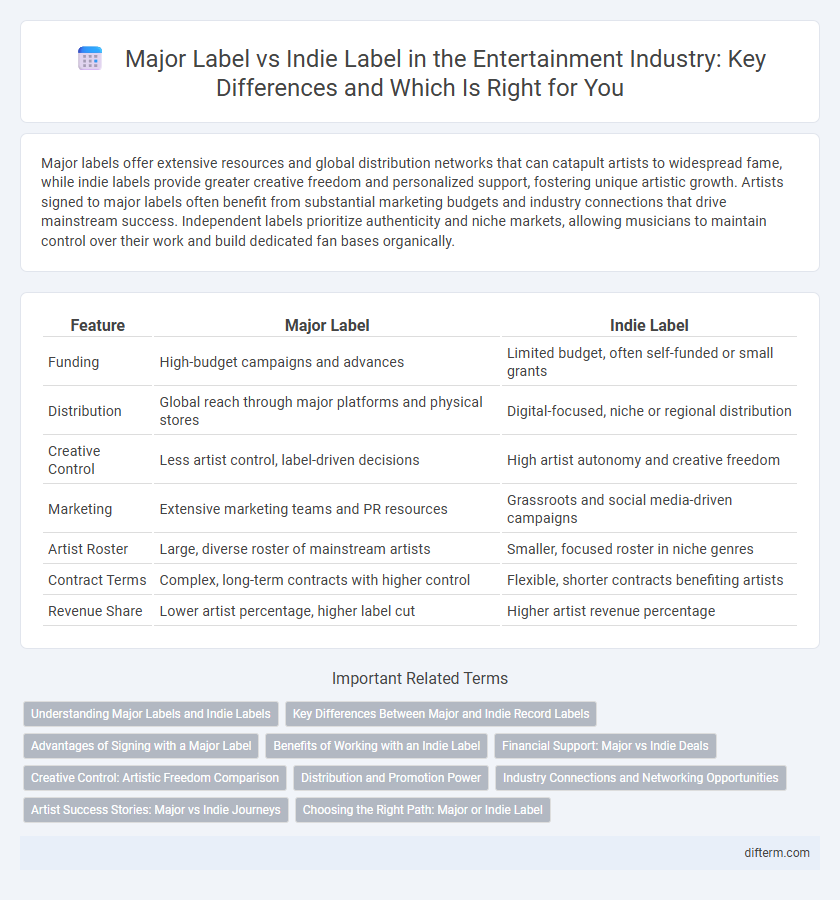Major labels offer extensive resources and global distribution networks that can catapult artists to widespread fame, while indie labels provide greater creative freedom and personalized support, fostering unique artistic growth. Artists signed to major labels often benefit from substantial marketing budgets and industry connections that drive mainstream success. Independent labels prioritize authenticity and niche markets, allowing musicians to maintain control over their work and build dedicated fan bases organically.
Table of Comparison
| Feature | Major Label | Indie Label |
|---|---|---|
| Funding | High-budget campaigns and advances | Limited budget, often self-funded or small grants |
| Distribution | Global reach through major platforms and physical stores | Digital-focused, niche or regional distribution |
| Creative Control | Less artist control, label-driven decisions | High artist autonomy and creative freedom |
| Marketing | Extensive marketing teams and PR resources | Grassroots and social media-driven campaigns |
| Artist Roster | Large, diverse roster of mainstream artists | Smaller, focused roster in niche genres |
| Contract Terms | Complex, long-term contracts with higher control | Flexible, shorter contracts benefiting artists |
| Revenue Share | Lower artist percentage, higher label cut | Higher artist revenue percentage |
Understanding Major Labels and Indie Labels
Major labels such as Universal Music Group, Sony Music Entertainment, and Warner Music Group dominate the music industry with extensive resources, global distribution networks, and significant marketing power. Indie labels, including Sub Pop, Merge Records, and XL Recordings, operate with smaller budgets but offer artists greater creative control and closer personal relationships. Understanding the differences in contract terms, revenue splits, and promotional strategies is crucial for artists choosing between major and indie labels.
Key Differences Between Major and Indie Record Labels
Major record labels offer extensive financial resources, global distribution networks, and established marketing power, enabling artists to reach wider audiences quickly. Indie labels typically provide greater creative control and personalized artist development but have limited budgets and smaller promotional reach. The key differences lie in scale, funding, artist autonomy, and market influence within the entertainment industry.
Advantages of Signing with a Major Label
Signing with a major label provides artists access to extensive resources, including high-budget marketing campaigns, professional production teams, and established distribution networks, which significantly enhance music reach and visibility. Major labels offer substantial financial backing for recording, touring, and promotional activities, enabling artists to focus on their craft while scaling their careers rapidly. Their deep industry connections also open doors to lucrative brand partnerships, award nominations, and prime media exposure, fostering long-term career growth.
Benefits of Working with an Indie Label
Indie labels provide artists with greater creative control, allowing them to maintain their unique sound and artistic vision. These labels often offer more personalized support and flexible contract terms, fostering a close-knit relationship that major labels may lack. By partnering with an indie label, artists can build authentic connections with niche audiences and retain a higher percentage of their royalties.
Financial Support: Major vs Indie Deals
Major labels provide substantial financial support for recording, marketing, and distribution, enabling artists to access top-tier studios, extensive promotional campaigns, and global reach. Indie labels offer more limited budgets but often allow greater creative control and a larger share of royalties, making them appealing for artists prioritizing artistic freedom over mass exposure. Financial deals with major labels commonly involve advances and recoupable expenses, while indie contracts tend to be more flexible with profit splits and lower upfront investments.
Creative Control: Artistic Freedom Comparison
Major labels often impose strict creative guidelines to ensure commercial viability, limiting artists' artistic freedom and direct input on their work. Indie labels provide greater creative control, allowing artists to experiment with unique sounds and personal storytelling without corporate constraints. This enhanced artistic freedom often results in more authentic and innovative music that resonates deeply with niche audiences.
Distribution and Promotion Power
Major labels possess extensive distribution networks and vast promotional budgets, enabling artists to achieve widespread exposure through mainstream radio, streaming platforms, and global marketing campaigns. Indie labels often rely on targeted, niche marketing strategies and digital platforms, leveraging grassroots support and social media to build loyal fanbases. The disparity in distribution reach and promotional resources significantly influences an artist's potential for commercial success and audience growth.
Industry Connections and Networking Opportunities
Major labels offer extensive industry connections and networking opportunities due to their established relationships with top producers, radio stations, and media outlets, enabling artists to access high-profile collaborations and promotional resources. Indie labels often provide more personalized support, fostering close-knit communities where emerging artists can build meaningful relationships with industry professionals and peers. While major labels deliver broad-scale exposure, indie labels excel in cultivating authentic, grassroots networks that can be pivotal for long-term artist development.
Artist Success Stories: Major vs Indie Journeys
Major label artists often benefit from extensive marketing budgets and wide distribution networks, leading to higher visibility and mainstream chart success. Indie label artists typically experience greater creative freedom and build dedicated niche audiences through grassroots promotion and authentic engagement. Success stories from both paths highlight diverse routes to stardom, with major labels driving global reach while indie artists leverage unique branding and direct fan connections.
Choosing the Right Path: Major or Indie Label
Major labels offer extensive resources, global distribution, and established industry connections that can accelerate an artist's commercial success, while indie labels provide greater creative freedom, personalized attention, and flexible contract terms. Artists must weigh the benefits of widespread promotion and larger budgets against the independence and artistic control available in the indie scene. Understanding personal career goals and artistic priorities is crucial when selecting between a major label's scaled infrastructure and an indie's nimble, artist-centered approach.
major label vs indie label Infographic

 difterm.com
difterm.com